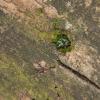New Hampshire is home to many small, diversified farms that are near and dear to my heart. I want to highlight a two-person operation run by a power couple that has been making major strides in pest management.
Winter Street Farm is a three year old business, run by owner-operators Abigail Clarke and Jonathan Hayden. They are certified organic and sell their vegetables through Community Supported Agriculture (CSA), which means that they grow almost every vegetable under the New England sun. They use the horsepower of tractors, but most of the merit goes to their clever minds, strong bodies, daily gumption, continuous learning, and their willingness to reach out to agricultural and conservation professionals for recommendations and financial assistance. It’s always a pleasure to visit their farm with my Natural Resource Conservation Service (NRCS) colleagues and plan preventative pest management strategies and pollinator habitat restoration.
Not all heroes wear capes, and these farmers will go to great lengths to protect their crop while also protecting pollinators. Jonathan and Abigail are extremely passionate about conserving native pollinators/beneficial invertebrates and avoiding the use of pesticides, while producing a marketable crop. They carefully rotate their crops, plant multi-species cover crops, transplant most crops for better seedling survival, trap and monitor for problem pests, and even physically vacuum up cucumber beetles!

Fending off flea beetles with exclusion netting
Last year, despite all of Abigail and Jonathan’s multifaceted efforts towards managing the brassica flea beetle, they experienced major crop loss, particularly on their tender leafy greens. This non-native insect wreaks havoc on their brassica crops (bok choy, tatsoi, radish, arugula, baby kale, hakurei, and any new planting of cabbage, kale, and broccoli), causing economic damage to their budding livelihood.
To address this issue, they physically exclude flea beetles from reaching their tender brassicas by installing hoops and covering them with insect exclusion netting – knee-high structures known as “low tunnels.” The keys to successful pest exclusion with low tunnels are to purchase a netting with a pore size that is small enough to exclude the problem pest, while still maintaining airflow, adequate light, and a reasonable temperature for the crop. Additionally, the netting must be anchored tightly against the ground and installed prior to the arrival of the pest – with special attention to crop rotation for soil borne pests!


Perennial plantings to host beneficial insects and pollinators
With pest management there are no silver bullets, but many overlapping methods can contribute to the overall health of the agroecosystem. One of Winter Street Farm’s tactics for keeping pest populations in balance is by planting mostly native flowering plants and grasses to host beneficial insects nearby their crops.
One alternative to purchasing and releasing farmed beneficials is a method called conservation biological control, which provides habitat for the wild invertebrates that are already present in the environment. Not only does it provide food (pollen and nectar) for pollinators and other beneficial insects, but perennial plantings provide long term shelter for these good guys to nest, overwinter, and for their young to emerge in following years. With this long term gain of newly planted diverse habitat comes some serious dedication to site preparation for a successful planting. Luckily, Jonathan and Abigail are aces with using tarp to terminate unwanted vegetation.
I’d say the future for Winter Street Farm is flowery and bright!

More information
- New Hampshire Audubon and Xerces Society collaborated on a webinar explaining New England specific site preparation methods, including black tarp.
- Interested in habitat restoration on private land? Reach out to your local USDA Natural Resource Conservation Service field office to start the conversation and potentially receive funding towards your conservation efforts.
- For more information on beneficial insects on the farm, check out Farming for Pest Management and Habitat Planning for Beneficial Insects: Guidelines for Conservation Biological Control.



